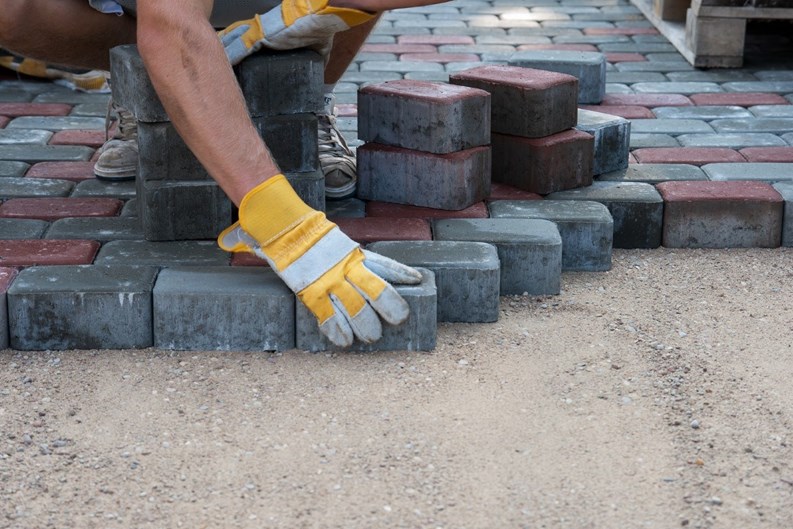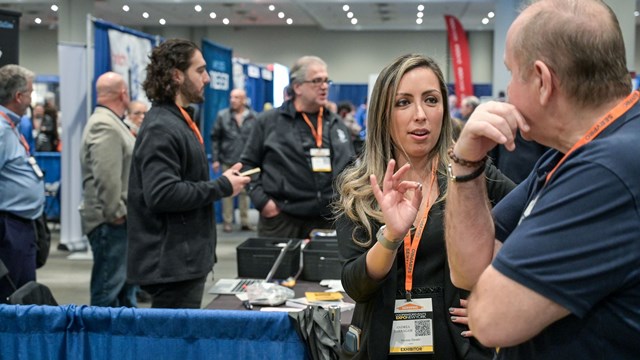Hardscaping—the use in a landscape design of non-living elements such as pavers, rocks, and trellises—is a major aspect of the three-year clubhouse expansion and transformation completed in 2013 at Broken Sound Club in Boca Raton.
A private community with more than 1,600 residences nestled beside two golf courses in 27 separate villages, Broken Sound spent $26 million on the project.
That total includes $6 million for a two-acre resort-style poolscape with a sprawling 10,000-square-foot contemporary free-form pool and a lushly landscaped tropical-style grotto. People swimming through the grotto pass behind and under what looks like a natural waterfall.
Other aspects of the poolscape include a five-lane lap pool; a heated whirlpool; and a children’s pool with a jungle gym, water slide, and splash pad—an interactive feature with intermittent jets of water through which children run. Surrounding the pools are 254 Valencia-style chaise lounges.
The plastic fiber surface of the poolscape’s synthetic turf playground cushion young trips and falls. “You can hardly tell the difference between real and fake grass. It breaks up the monotony of large expanses of pavement, it’s maintenance-free, and it has a 10-year warranty,” says Bryan Donahue, director of the landscape architecture division at Land Design South in West Palm Beach, which created the poolscape.
The adjacent former pool bar was transformed into The Bistro, a 4,000-square-foot casual restaurant with an outdoor terrace overlooking the poolscape.
“Broken Sound created a tropical resort outside its clubhouse. Now they plan to expand the pool deck area because so many people are using the space,” Donahue reports. “Many South Florida homeowners’ associations and country clubs are expanding the amenity areas around their clubhouses to appeal to younger generations. That gives us an opportunity to create these beautiful environments with pool facilities, fire pits, and outdoor dining. Everybody wants to be outside in Florida.”
A Lot or a Little
Hardscaping need not be as expansive or expensive as the Broken Sound poolscape. HOAs and condominiums may just want to add a path of pavers or plant a few rocks to liven up an existing garden, but Ken Kertznus, co-owner and managing director of Miami Outdoor Solutions, recommends proper planning before anything is done.
“You need an architectural landscaping plan—a survey of the property,” he says. “Map out the current existing landscaping, calculate the square footage and cubic yardage of existing garden beds, and then come up with a viable solution.”
Issues to consider include:
• Do existing garden beds have borders or curbs? If not, and you just lay stones around them, rain may wash away the stones.
• How deep is the soil bed? Is it deep enough to remove soil and install a liner beneath the rocks?
• To build a driveway, after you remove the sod and soil bed, will you need a Bobcat to break up the limestone under the soil before pouring concrete or creating a silica sand base for pavers?
• Is the drainage suitable, or does the area being worked on need regrading? You don’t want to direct runoff toward buildings, sidewalks, and parking lots, or create depressions where puddles linger after each heavy rain.
• What kind of topsoil are you working with? Kertznus says South Florida topsoil is extremely variable in quantity and quality, with more in Broward and Palm Beach counties than in Miami-Dade County. “Topsoil may have more nitrogen and potassium from one street to the next, and that affects the landscaping,” he says. “If we bring in new topsoil, we’ll try to give you the same foliage that the people across the street have.”
• Does your building have a retaining wall with a flower bed? Kertznus warns that because such constructions typically lack drainage holes, they trap moisture that forms mold on the building wall. Also, he says, they require constant maintenance and attract weeds. “The ideal solution,” he says, “would be to remove the retaining wall, but many owners’ associations don’t want to do that. Then I advise them to forget about plants there, take the topsoil out, and fill the space with Chattahoochee rock.”
The Heat-Island Effect
In your planning, consider the timing and duration of direct sunlight on your hardscape at various seasons of the year. You want to avoid the heat-island effect—the elevated temperatures that result where hard non-living surfaces capture and exude heat.
“Strategically locate your hardscapes where some shade already is present, or where the building will shade them for part of the day,” Donahue advises. “Shade is very important. If you add hardscape, add more landscape area. Add a gazebo, or a new patio with canopy trees to provide shade and drop the temperature in those areas.
“A large water feature in the midst of a hardscape also can reduce the heat-island effect, even if the temperature in direct sun is 90 degrees F. If you’re building a large patio, put a fountain or waterfall on one side or in the middle to absorb some of the sun’s heat.”
Another way to combat the heat-island effect is to use light-colored paving. Black asphalt retains more heat. So does gray cement, which is used to make concrete in red and other dark colors. White cement, used for light-colored concrete, retains less heat and will be somewhat cooler—a benefit on pool decks where people walk barefoot. Natural stone and wood are even cooler than concrete.
Be Flexible
Kertznus advises clients not to approach hardscaping with preconceived notions. “Have someone determine what you can do,” he says. For example, the developers of the Canyon Ranch condo hotel on Miami Beach wanted to replicate the rocky desert look of their resort in Phoenix, Arizona, but ultimately chose a tropical design with palm trees more appropriate to south Florida.
“We look at what will work and what won’t,” Kertznus says. “We evaluate the terrain and the architectural appearance of your building, recommend the best products, and also look at the budget. Then we design something based on a client’s budget and the functionality and practicality of the design—how we’re going to implement it in their particular situation. Hardscaping products are very expensive, so we want to be realistic.”
Kent Rodahaver, owner of GreenScapes Landscape Design in St. Petersburg, says association boards may have a wish list and budgetary constraints. “The challenge is to meet somewhere in the middle and have everyone happy,” he says. “Sometimes we can use different materials that mimic more expensive materials, so we get a similar effect for less money.”
Maintaining a
Hardscape
In general, hardscapes require much less maintenance than landscapes full of growing plants.
Donahue recommends pressure-washing a concrete-paver patio once or twice a year to control build-up of algae, dirt, and mold in the cracks. “If you get weeds popping up through joints in the pavers, you’ll want to spray them with an herbicide,” he says.
Some hardscape surfaces employ higher-end natural stone products such as marble, travertine, and slate, which require periodic sealing to protect the stone from staining. Every six months to a year, such products should be pressure-washed and resealed.
Walkways, patios, and other paved surfaces may settle over time. “After five or 10 years, you may need to pop a couple of pavers out and put some fill in under them,” Donahue says. “With concrete, you would have to remove a section and repour. The paver system is much easier to maintain and to fix problems.”
“You may have to monitor a rock garden or rock path for movement from erosion,” Rodahaver says. “With crushed shell you may get a washout. We use crushed shell quite a bit for driveways and pathways. It’s abundant in Florida, attractive, inexpensive, and very hardy.”
The heavy iron content of the water used in many south Florida irrigation systems may discolor porous surfaces, but Rodahaver says stain-removal products exist. “Apply such a product annually, or as needed,” he advises.
A hardscape garden with no plant materials can be essentially maintenance-free, Kertznus says. “When we lay a stone garden, we use synthetic wool to cover the sub-graded area or exposed topsoil, to discourage weeds from growing,” he explains. “We poke some holes along the corners for drainage, and install a drainage system so the water can dissipate through the rocks into the holes and then into the ground.”
For a hardscape that contains some plantings, Kertznus recommends anti-fungus treatment; annual application of a fertilizer containing two percent nitrogen, six percent potassium, and eight percent phosphorus; and periodic pruning and weeding to maintain the garden’s appearance.
Choosing the Right
Professional
When you consider a hardscaping project, first ensure that the person or company you choose to work with has appropriate training and credentials. What constitutes the “right” credentials depends on where you’re located and what you want done. The state has requirements, and so do some individual counties and municipalities. Miami-Dade County, for instance, says all landscapers must have an occupational license, but that alone lets them perform only the simplest of hardscaping tasks.
A state-licensed building contractor should be involved in any hardscaping project that entails construction, such as a driveway requiring excavation and pouring concrete, or a structure such as a gazebo, trellis, or pergola. Florida also requires an engineering concrete license for basic concrete work, a separate finishing license for brush and concrete coloring work, and a specialty license for paver and tile work.
Other available credentials include a state license as a commercial landscape maintenance company, Green Industries BMP (Best Management Practices) Certification, certification as a Landscape BMP Trainer, and various federal and state Environmental Protection Agency certifications.
In addition, trade and professional associations have their own certification and designation programs, some of which provide continuing education credits used to gain and maintain state certifications. They include the American Concrete Institute, the Interlocking Concrete Pavement Institute, the Marble Institute of America, the National Tile Contractors Association, and the Tile Contractors’ Association of America.
“I’m a huge advocate for education,” Rodahaver says. “We compete on a daily basis with folks who aren’t certified, licensed, or insured. We clean up after such people.”
George Leposky is a freelance writer and a frequent contributor to The South Florida Cooperator.





Leave a Comment